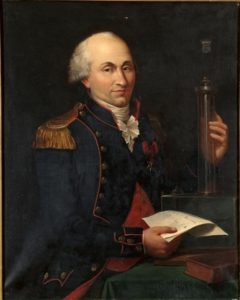Atomic Structure
Coulomb’s Law

Charles Augustin Coulomb was a scientist after whom the unit of charge was named. Coulomb’s Law states:
A force exists between two point-source charges that is directly proportional to the product of the two charges and inversely proportional to the square of the distance between the charges.
A coulomb is the unit of charge, symbolized by C. One coulomb is the total charge carried by 6.25 X 1018 electrons.
A formula to calculate the coulombs of charge for a certain number of electrons is shown below:
[latex]Q=\frac{Number of electrons}{6.25 X 10^{18}C}[/latex]
Example
How many coulombs of charge do 65.5 X 1031 electrons have?
[latex]Q=\frac{65.5 X 10^{31} electrons}{6.25 X 10^{18} C}= 104.8 X 10^{12} C[/latex]

